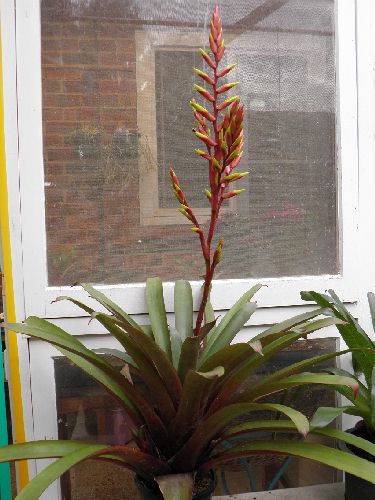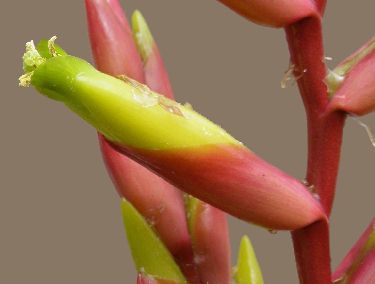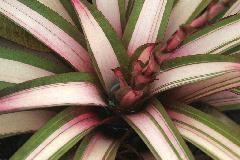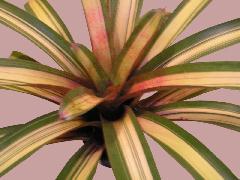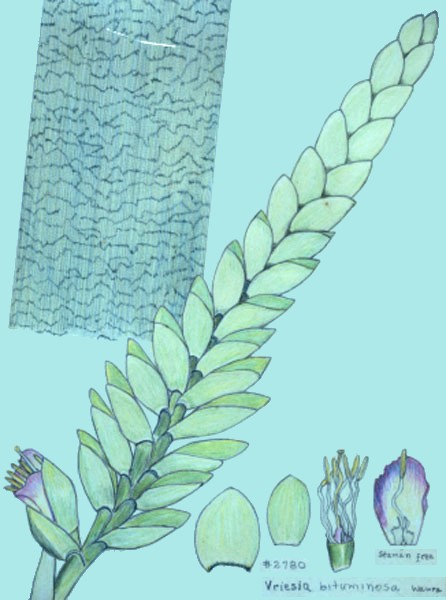
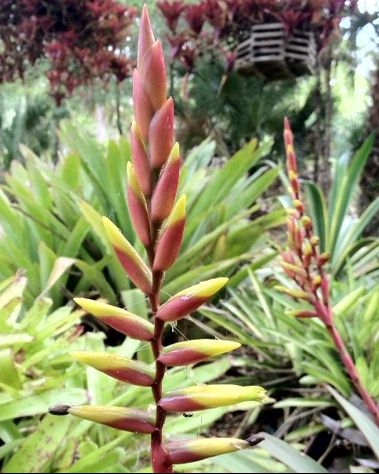
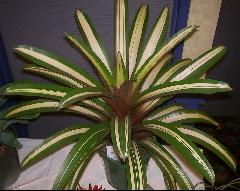
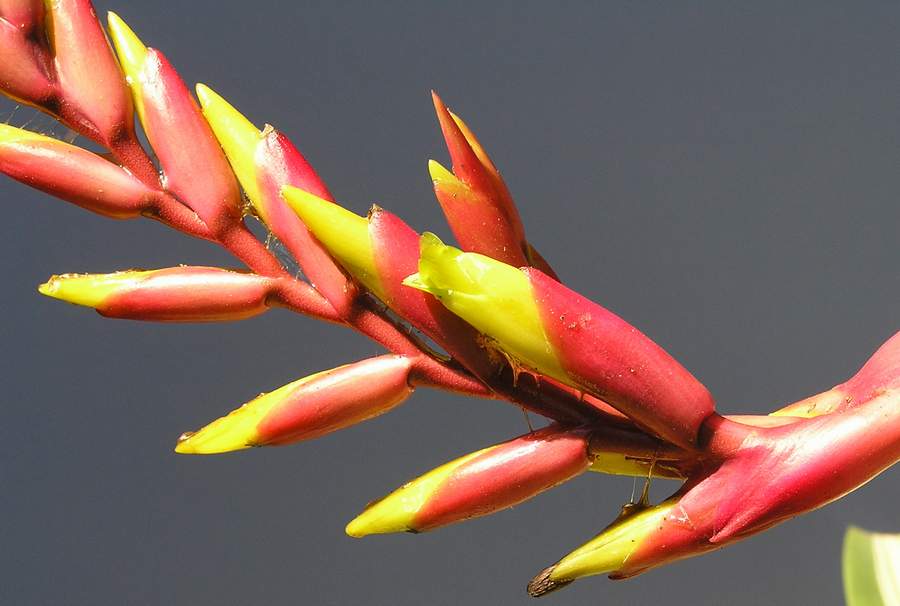
This problem has been bugging me since 2001 when Peter Huddy thought he had solved the problem of two variegated Vrieseas that had been imported to Australia under parentage formula from the USA.
We know that parentage formulae are often reversed and that forms of variegation do vary. In 2011 Vriesea ‘Shiraz’ was registered:
Vriesea ‘Shiraz’
Hybridist unknown, named by Peter Huddy, SA, Australia. Named in 1995.
(platynema x saundersii)
Plant 60cm diam, flowering to 90cm high. Has never shown signs of variegation in 20 years cultivation in SA.
Although this has the reverse parentage to that reported for the variegated ‘RoRo’ there appears to be great similarity and thus similar origins.
Reg Doc by M Butcher 11/2011.
The only way to answer this problem was to try find someone in the USA who was still growing plants called V. bituminosa x saundersii (variegated) and this was Michael Kiehl of Michael’s Bromeliads in Florida. Michael promised to send me a photo of the plant in flower and did so in March this year.
We now have photos of all plants involved in this saga. They have a red floral bract, yellowish sepals and light green petals. All have discolor leaves.
The problem seems to be on what was considered to be V. bituminosa when the hybrid was done many years ago. If we look at Flora Neotropica by Smith & Downs 1977 we will see that even the botanists had problems with identity involving V. platynema whereas, these days, most of us know how to identify V. bituminosa with its brownish petals ( see Foster’s painting of his V. bituminosa for another problem regarding colour.)
The most likely scenario is that first we had platynema x saundersii (now called 'Shiraz') which sported variegation but some had different variegation and some bright individual felt one had ‘bituminosa’ in it not ‘platynema’ - and even reversed the parentage.
We should continue to use the names 'Shiraz', 'Highway Beauty', ‘Highway’( non-variegated ‘Highway Beauty’) and 'RoRo' because so many are growing plants under these names ( as well as saundersii x platynema AND platynema x saundersii plus or minus the notation ‘variegated AND bituminosa !) but remember we are dealing in all probability with the same hybrid. In our experience the plant in Adelaide called 'RoRo' has a more stable variegation pattern but then this could be different in a different climate. All have the V. saundersii spotting of the leaves at some time in various intensities in their life to flowering.
'Highway Beauty' was named from a plant in Adelaide, South Australia because it had so-called ‘bituminosa’ in its parentage. This particular clone is still here but I would doubt that an offset actually escaped from here. The only logical solution is that growers in Australia and/or the USA were growing variegated plants with ‘bituminosa’ somewhere in the formula on the label and automatically assumed it must be 'Highway Beauty' . We know this happened in New Zealand where Peter Waters maintains their 'Highway Beauty' does not link to V. bituminosa.
This is yet another example of non-action by the hybridist and while we now have a tenuous solution it is a muddled one.
Previous writings on the subject follow:
Vriesea ‘Highway Beauty’ (bituminosa x saundersii) and Vriesea ‘RoRo’ (saundersii x platynema) by Butcher 10/2009.
Remember that since 2005 there is only one name for a variegated Bromeliad irrespective of the form of variegation it has. These forms can be added as adjectives if felt necessary.
Towards the end of 1990’s Peter Huddy of Adelaide, acquired these variegated plants from Queensland under the formula as quoted and wondered why they had not been given names and registered them. Despite searches he was unable to trace a source but it seemed to be in Florida. In 2001 he decided to grandfather them into the system. The bituminosa reference took Peter to bitumen and thus ‘Highway’ and the other he used the nickname of his daughter.
Strictly speaking only the plants named by Peter should have these names but what do you do with plants around the world with this quoted parentage. Formulas are so misleading. It is a pity these plants were not given names by the hybridist concerned or even by the person when the first variegation appeared. If anyone has information in this regard please contact the writer
How accurate is this formula? Could the formula have been ‘corrected’ after the first release. Could the label have been carelessly written. We know that in the 1980’s little care was taken that the seed parent comes first.
In my search for references to these parentages I tried all avenues. There is no reference in the Journal of the Brom. Soc. There is reference to a (bituminosa x saundersii) and reverse in Brian Smith’s 1984 Manuscript. This, no doubt, came from Hill’s 1984 catalogue which has reference to Bert Foster. One can only assume this was not variegated because this form always attracts a higher price. It would also seem to be the plant that got to Australia in July 1986 and recorded in the ledger of PineGrove Nursery, NSW, under #2952.
What is recorded for variegated plants? In 1993 we see in the catalogue for The Olive Branch, Qld reference to saundersii hybrid variegata and a saundersii hybrid albomarginata. Is there a tenuous link here?
Vriesea (bituminosa x saundersii) References found:
1997 Pineapple Place, Florida, (saundersii x bituminosa) variegata - note reverse parentage
2004 Michael’s Bromeliads, Florida, (bituminosa x saundersii) variegated
Vriesea (saundersii x platynema) References found:
1986 Pine Grove Nursery #2941 (platynema x saundersii) variegated ( from USA)
2004 Michael’s Bromeliads (saundersii x platynema) albomarginate
See Bromeliad (NZ) 42(9): 2002
From the Registrar by Gerry Stansfield:
This month we have two very interesting vrieseas that have been around.
The second vriesea has been around for some time and unnamed is a cross between V. saundersii and V. bituminosa. I can remember seeing this plant in Harry Martin’s collection back in the late 1960’s and these came from the very famous Muriel Waterman’s collection, who was a hybridiser and seed grower, and remember that both bituminosa and saundersii are very old and early vrieseas, and it is possible that this lovely cross originates there.
Anyway, this plant has been called ‘Highway’ and the connection is bituminosa sounds like bitumen for sealing our highways. Vriesea ‘Highway’ sported a variegated plant, and it is this we will show as Vriesea ‘Highway Beauty’. It is truly a lovely variegated plant and makes a fine specimen as we saw last month at our Auckland meeting with Marie Hesley’s plant from Hamilton. To add more confusion, there is another form and that is albomarginated. All these plants have multi bract spikes which they have taken from V. saundersii as V. bituminosa has a ladder type spike.
Not to be confused with Vriesea ‘RoRo’, which is V. saundersii x V. platynema and can be variegated or albo-marginated.
From Bromeliad (NZ) 48(11): 2008
Vriesea 'Highway Beauty' a bit of a mystery- Article and photo by Peter Waters.
For many years we have been growing a very attractive variegated Vriesea as 'Highway Beauty' but formerly under the formula bituminosa x saundersii. The name 'Highway Beauty' was registered in 2002 by Peter Huddy of Adelaide. Since then 'Highway' has been applied to the non-variegated version. In 2001 Peter Huddy registered a very similar plant as Vriesea 'RoRo' (saundersii X platynema)
In New Zealand the plant first surfaced as Vriesea bituminosa x saundersii and eventually adopted the name ‘Highway Beauty'. For some time I have felt that there is something amiss here. Vriesea bituminosa is a very large wide-leafed bromeliad with a large dark patch on the leaf tips, and our 'Highway Beauty' seemed to resemble platynema more than bituminosa. However I didn't really worry too much until I had a Vriesea platynema var platynema flower. It had come from Elton Leme in Brazil and the floral bracts were a bright pinkish red, totally unlike Vriesea platynema var. variegate, a night-flowering plant, which has rather colourless flowers. Incidentally, EIton says that they are not the same species and he will at some time alter the name of platynema variegate back to its original name Vriesea gamba ( Currently hiding under V. jonghei! - Butcher). At this stage I began to wonder why the flower on our 'Highway Beauty' was bright pinkish-red. Vriesea saundersii has yellow floral bracts and petals and bituminosa has green or pale yellowish flowers like most night-flowering vriesea. At this time I am still trying to find a 'Highway Beauty' with a flower that is not red, and until I do, I am thinking that all our Vriesea ‘Highway Beauty' should be named Vriesea 'RoRo’. I remain to be convinced that ‘Highway Beauty' actually exists, at least in New Zealand.
